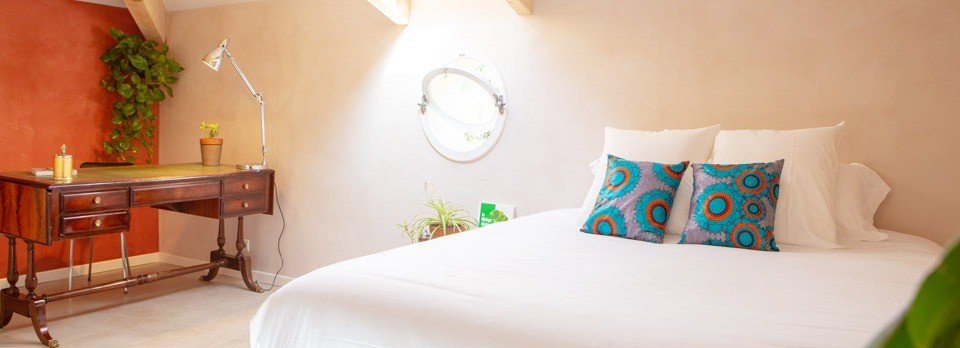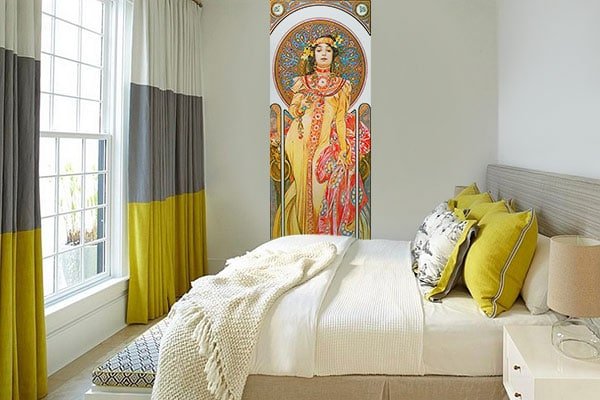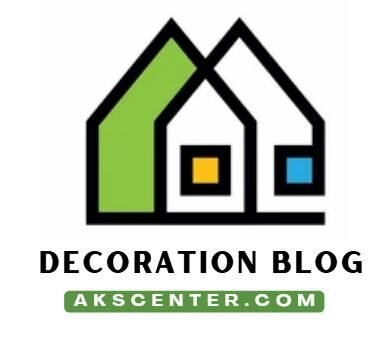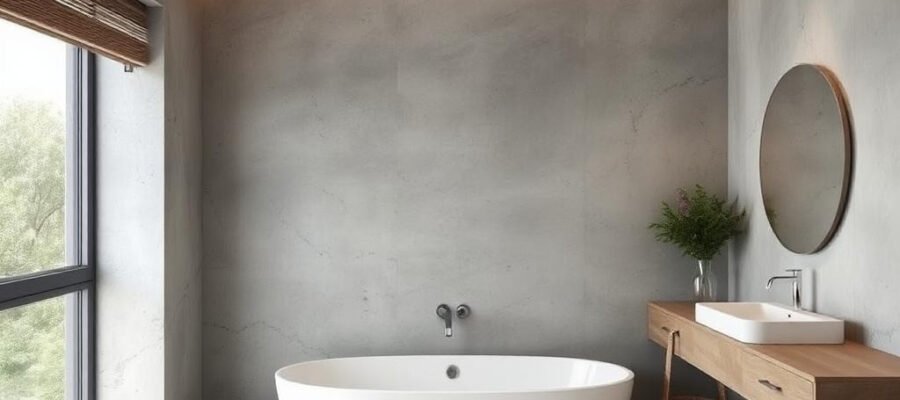Choosing the right color for polished concrete can transform an interior. This versatile material is increasingly used in renovation projects due to its sustainability and modern aesthetic. However, with such a variety of shades and patterns available, selecting the perfect color can become a real challenge. The color of the concrete must not only match the specific room but also harmonize with the overall decor and existing elements. Whether creating a relaxing atmosphere, enhancing spatial perception, or complementing structural elements, each shade plays a crucial role. In this article, we will detail the key factors to consider when choosing the best concrete color for your interior, while exploring current trends and customization options to help you refine your space.
Consider the Room’s Lighting
Lighting is one of the first elements to evaluate when selecting a concrete color. Each room has unique lighting conditions depending on window size, orientation, and the amount of natural light available. Light colors, such as off-white, beige, or pearl gray, reflect light better, creating a sense of spaciousness and brightness. These shades are ideal for smaller rooms or spaces with limited natural light.
For well-lit rooms with ample sunlight, darker and more distinctive shades, such as anthracite gray or deep blue, can be used to create contrast and visual interest. It is important to play with both natural and artificial light to determine the best color choice for the concrete.
A useful tip is to test the selected color in the room before making a final decision. Apply a sample to a small section of the wall or floor and observe how it changes throughout the day under different lighting conditions.
Consider the Function of the Room
The function of a room plays a vital role in selecting the right concrete color. Each space in a home has a specific purpose, directly influencing the atmosphere to be created. For a bedroom, for instance, soft and relaxing shades such as light gray, powder pink, or sand beige can help establish a peaceful environment conducive to rest and relaxation. These subtle shades add lightness to the space and promote a calm ambiance.
In areas like the kitchen or living room, more dynamic colors can be explored. A charcoal gray or deep teal adds character to these spaces, where energy and interaction take place. The color choice can also help define different areas within an open-plan space. For example, using a different shade of concrete in the kitchen from that in the living room can visually separate the two areas without the need for partitions.
For a bathroom, natural colors like white, beige, and sand are ideal as they enhance the sense of cleanliness and tranquility. Polished concrete is also highly resistant to humidity, making it a perfect choice for this space.
Choosing a Color Based on Decorative Style
Your interior’s decorative style should also guide your choice of concrete color. Each style has its unique characteristics, and the right shade can enhance these stylistic choices. For a Scandinavian-inspired interior, white, light gray, and beige tones are preferred for their ability to reflect light and create a serene, refined atmosphere. Combined with natural wood elements, concrete adds warmth and comfort to this aesthetic.
For an industrial-style interior, dark gray, anthracite, or even black concrete integrates seamlessly. Industrial design favors raw materials and metal finishes, making polished concrete a natural fit. Pair it with metal accessories and wooden furniture to enhance this contemporary urban look.
In a bohemian-style setting, warm and earthy colors such as terracotta, sage green, and muted tones work well with polished concrete. These shades add warmth and a welcoming touch, creating a cozy and inviting space.
The Color Chart: An Essential Tool
Choosing the right concrete color is easier with the use of a color chart. This tool allows you to visualize and compare different shades, helping you select the one that best suits your desired ambiance. A color chart helps identify how certain colors that seem perfect in photos might not work as well in reality.
It is also advisable to obtain polished concrete samples. Applying a sample directly to the intended area provides a clearer idea of the final look. This step allows you to assess the color’s intensity, how it reacts to the room’s lighting, and how well it matches other decor elements.
A color chart can also serve as an inspiration tool, encouraging the exploration of bolder shades. While people often opt for neutral colors for safety, a color chart can broaden horizons and introduce unique tones that make a significant difference.
Matching Concrete Color with Furniture and Accessories
The choice of concrete color should also consider the furniture and accessories already present in the room. It is essential to ensure that the selected shade complements the furniture, creating a cohesive look. For light wood furniture, colors like beige, pearl gray, or sage green work well to maintain visual balance.
For spaces with metal or dark wood furniture, concrete shades such as anthracite gray or deep blue can create an intriguing contrast. Conversely, if the room already features vibrant accessories, opting for a neutral concrete color helps prevent visual overload.
Textiles, such as rugs, curtains, and cushions, also play a significant role. These elements contribute greatly to a room’s personality and should align with the concrete color to ensure a harmonious aesthetic.
Current Trends in Polished Concrete Colors
Some concrete colors are currently trending, offering contemporary and elegant interior solutions. Warm earthy tones, such as terracotta, are popular for adding warmth and a natural touch to a space. These colors evoke organic elements, making them ideal for creating a soft and inviting atmosphere.
Olive green and sage green are also in high demand, especially in kitchens and bathrooms, as they bring freshness and a connection to nature while remaining neutral enough to pair with other colors. These shades are both calming and nature-inspired, making them perfect for spaces designed to foster tranquility.
Darker shades like midnight blue, anthracite gray, and deep black are trending for modern and industrial-style interiors. These colors add depth and sophistication, creating an intimate ambiance. Combining them with brass or copper accents further enhances their refined look.
Mistakes to Avoid When Choosing a Concrete Color
Selecting the right polished concrete color is not always straightforward, and certain mistakes should be avoided to ensure a harmonious result. One common mistake is neglecting to consider the room’s lighting, which can make a shade appear too dark or overwhelming. Another is choosing a color based solely on online images without testing real samples under the room’s lighting conditions.
Additionally, using too many colors in the same space can create a chaotic appearance. Polished concrete works best when highlighted through simplicity and elegance. Choose a color that complements the existing decor without introducing too many contrasting shades.
The Impact of Finishes on Concrete Color
The choice of concrete finish is as crucial as the color itself, as it affects the final appearance. A matte finish gives a softer, more elegant look, while a glossy finish adds a modern touch by reflecting light and creating the illusion of a larger space.
Finishes also influence color perception under different lighting conditions. For instance, a glossy finish can make a color appear more vibrant, whereas a matte finish absorbs light, making the shade appear softer. Choosing the right finish depends on the desired effect and the ambiance you wish to create.
A satin finish offers a balanced option between matte and glossy, providing a soft and pleasant texture with a slight reflection. This finish is particularly well-suited for living rooms, adding warmth and elegance without being overly reflective.
When choosing a polished concrete color, it is essential to consider lighting, room function, decorative style, and existing furniture and accessories. Testing samples and using a color chart can help avoid unexpected results. Polished concrete is an incredibly adaptable material, and the right color choice can enhance its beauty while creating a cohesive and stylish interior. Take your time, explore different possibilities, and let your creativity guide you in transforming your space!
Ultimas Entradas Publicadas

How to paint a wall without traces (roller)?

Which color in concrete concrete to choose?

Place in the new skull design table

Cement cement texture

How to paint a room: what color and what kind of paint to choose?

Tadelakt in a bathroom: step by step

Art Nouveau Style Decoration

10 contemporary paintings that will make you travel

Tension tables: new creations


